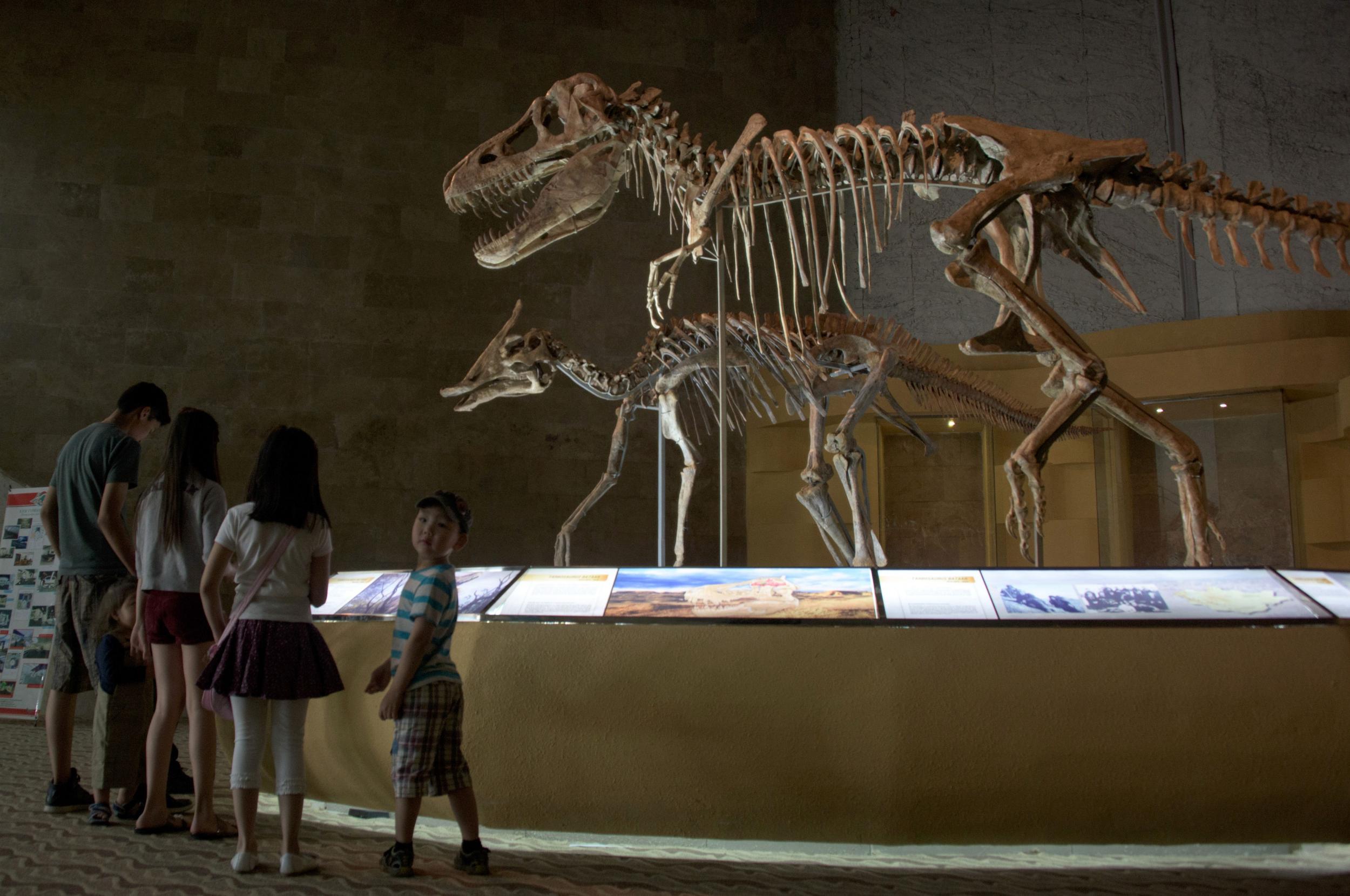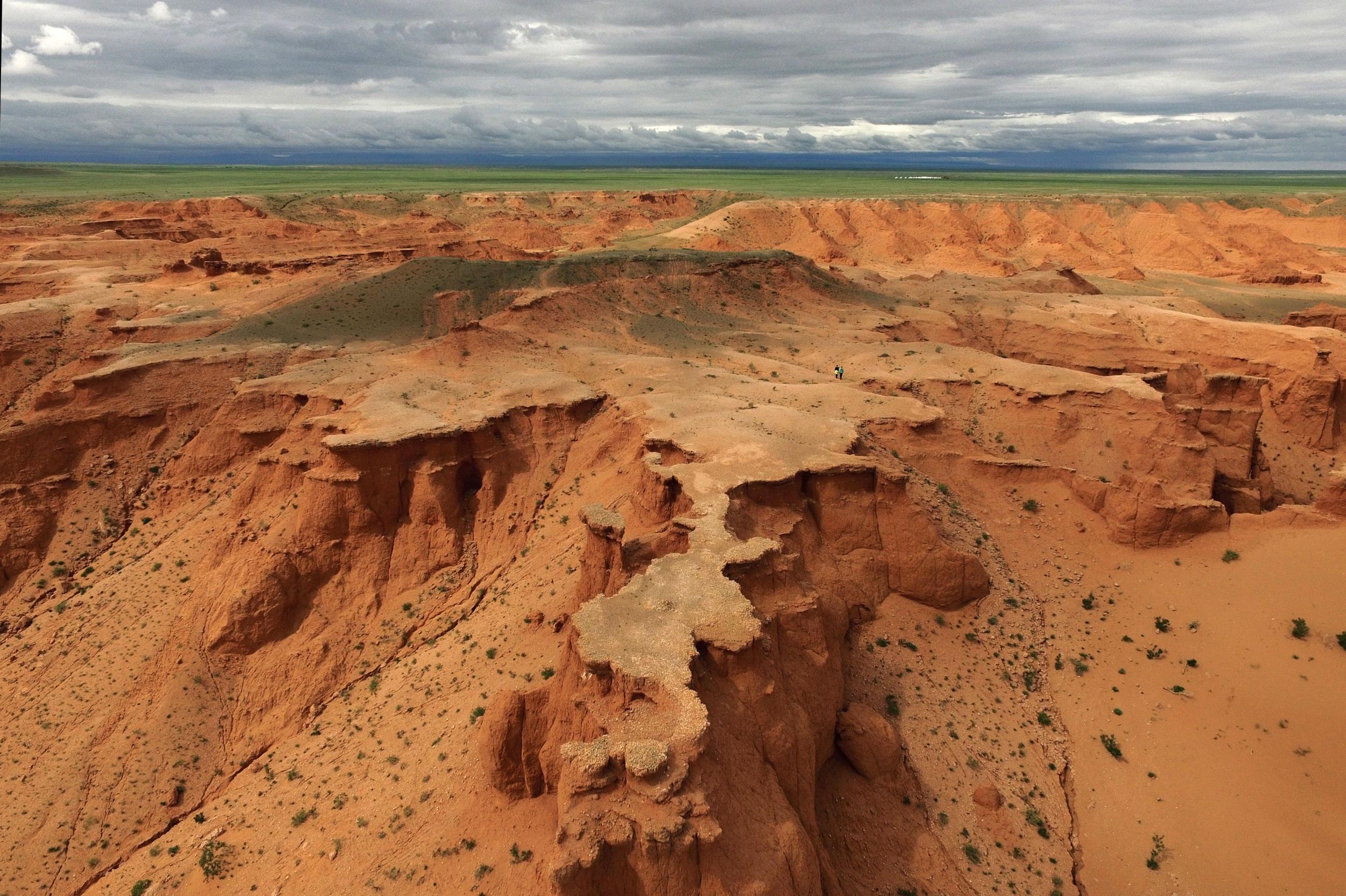The strange story of the real-life Indiana Jones and Mongolia's fight to recover stolen dinosaur fossils
They fetch hundreds of thousands of dollars at auction, writes Andrew Buncombe, but to the country where they were plundered they are priceless


When Bolortsetseg Minjin learned that a Mongolian Airlines plane had taken off from Seattle International Airport this week, she enjoyed a few moments of celebration.
The blue, white and yellow-liveried Boeing 767 had made the airline’s first direct flight to the US, to deliver medical gear to help in the fight against coronavirus, which is under tight control in Mongolia yet still raging in America. Moreover, it was returning with two invaluable pieces of cargo. On the flight to Ulaanbaatar were 255 Mongolian citizens, stranded in the US since the pandemic struck. Along with them were several boxes of dinosaur fossils, more than 65 million years old, illicitly obtained and now being returned to their rightful home.
The fossils, of creatures such as Tarbosaurus bataar, a relative of Tyrannosaurus rex, had been originally found in the vast Gobi desert, known by palaeontologists around the world. It was there in the 1920s and 1930s that American explorer Roy Chapman Andrews found the first fossilised dinosaur egg, and with it proof that dinosaurs were reptiles.
Yet, while the whip-carrying Andrews, said to be the true-life inspiration for Steven Spielberg’s Indiana Jones and who died in 1960, obtained permission for his expeditions from the Mongolian government, many who followed – either in person, or through intermediaries – did not. The fossils packed into the hold of the Mongolian Airlines plane, among them two fossilised skulls of Tarbosaurus bataar, represented the latest success in a decade-long effort to locate and repatriate artefacts she passionately believes belong in her native Mongolia.
“It feels good [to see the fossils returned],” says Bolortsetseg, whose father was also a palaeontologist, and who now lives in New York where she heads the non-profit Institute for the Study of Mongolian Dinosaurs.
“I really want dinosaur fossils that are from Mongolia to be displayed in Mongolia, and for the public to learn about their cultural heritage.”
She adds “They have a lack of knowledge and they’re not appreciating this heritage as much as they should have been. Because of that, we are facing this problem of people selling fossils for money.”
Bolortsetseg’s work has seen her travel the United States, working with both the government of Mongolia and officials from the the US Department of Homeland Security’s Immigration and Customs Enforcement (ICE) responsible for the investigation of stolen items. On several occasions, she has acted as an expert witness in court cases, where lawyers for the Mongolian government sought to prove items were genuine.
She has done so as dinosaur fossils, perhaps as a result of films such as Jurassic Park, which Spielberg also directed, have become increasingly sought after, often as status symbols.
In 2015, actor Nicolas Cage voluntarily handed over a Tarbosaurus bataar skull he had bought in auction in 2007, and for which he had paid $276,000, outbidding Leonardo DiCaprio among others. Cage did so after prosecutors in New York filed a civil forfeiture claim, saying the item had been obtained illegally.
Part of the challenge for people such as Bolortsetseg is that since 1990, when Mongolia established a democracy after six-decades of Soviet-controlled rule, her nation has become increasingly open to the outside world. While Mongolia has had laws dating back to 1924 that make fossil collection or removal illegal, collectors and enthusiasts have taken advantage of the increased ease of access to the world’s most sparsely populated nation and its cultural treasures.
Two areas in particular, the Flaming Cliffs, and the Nemegt Basin, both in the southern Ömnögovi Province, have attracted huge interest.

“When you open up, it’s not just well-wishers who arrive, but also those looking to make quick money,” says Yondon Otgonbayar, Mongolia’s US ambassador, who travelled to Seattle to oversee both the arrival of the PPE equipment, and the return of the fossils. “Now we’re working to recover those stolen items.”
Bolortsetseg estimates in the past decade she has helped repatriate more than 50 individual dinosaur fossils or collections, that were flown back in four shipments, Sunday’s being the most recent. Several legal actions to recover other fossils are ongoing.
Other than of the skull bought by Nicolas Cage, the most high-profile involved an entire Tyrannosaurus bataar skeleton, obtained among a number of dinosaur fossils by a Florida collector, Eric Prokopi, and put up for sale in New York city for $1m in 2012.
Prokopi would eventually plead guilty, as part of a deal with federal prosecutors, to illegally smuggling dinosaur fossils and give up several other skeletons in his possession. The skull bought by Cage had in fact been originally obtained by a gallery in Beverly Hills, IM Chait. The gallery had bought a number of items from Prokopi, who initially argued he had committed no crime because the fossils had been brought to the US from the UK, rather than directly from Mongolia. He was jailed for three months.
“Each of these fossils represents a culturally and scientifically important artefact looted from its rightful owner,” said then Manhattan prosecutor Preet Bharara. He called Prokopi a “one-man black market in prehistoric fossils”.
The pieces returned this week followed investigations by ICE agents in several locations across the country. Bolortsetseg said three separate legal actions were involved.

“In 2012, officers in New York, Wyoming and Salt Lake City initiated cultural property investigations related to the sale of dinosaur fossils that originated in Mongolia,” says ICE spokesperson Kate Pote. “Mongolian patrimony laws prohibit the export and private ownership of any prehistoric dinosaur fossil or specimen.”
Pote says a fourth case, again involving Prokopi, was in the process of being resolved and ICE planned to “release this fossil to Mongolia in the coming months”.
It is unclear whether Prokopi, the subject of a book, The Dinosaur Artist: Obsession, Betrayal, and the Quest for Earth’s Ultimate Trophy, by Paige Williams, was directly inspired by Roy Chapman Andrews, who launched three separate expeditions to Mongolia, in the capacity as an explorer for New York’s American Museum of Natural History (AMNH), where he started his career in 1906 mopping the floors. He would later graduate to the taxidermy department before travelling through Mongolia in US-made cars he imported for the purpose.
“I wanted to go everywhere. I would have started on a day’s notice for the North Pole or the South, to the jungle or the desert,” he wrote in Under a Lucky Star, one of a dozen books.
To some, such as the Roy Chapman Andrews Society, established in the explorer’s birthplace of Beloit, Wisconsin, Andrews was a pioneering hero, who auctioned off some of the eggs he brought back to the US in order to fund subsequent expeditions. In 1935, he became director of the prestigious AMNH, where a number of his Mongolian dinosaur finds are still on display.
Others, including Bolortsetseg, say his actions took place in a less informed era. “Hero is not the word,” she says. His intention may have been good, she adds, but “this whole thing happened around the time of a colonial mindset”.
The AMNH did not respond to enquiries. In a statement, the Roy Chapman Andrews Society said it was “focused on promoting the value of scientific exploration and discovery, with special emphasis on inspiring young people to achieve great things”. It added: “We recognise many historic achievements were the product of colonialism and we support efforts to redress this legacy.”
Indeed, the repatriation of items to Mongolia comes amid a broader cultural reckoning, with many nations, and their museums, being pressured to return items collected, or looted, depending on one’s perspective, during colonial times. Last year, the authors of an influential report accused the British Museum of acting like an “an ostrich with its head in the sand” over the issue.
In Mongolia, over the last decade there has been an urgency to use the publicity created by the return of the dinosaur fossils to educate people about their heritage. A museum was specially constructed to house the fossils.
Among those who supported this was Oyungerel Tsedevdamba, a writer and activist and onetime minister of culture, sport and tourism.
Speaking from Ulaanbaatar, Oyungerel tells The Independent that one of the challenges in educating Mongolians was the historic views of bones as something unclean. Oyungerel, who grew up in a nomadic herding community, says children are taught to keep away from the bones of dead animals, as they may be harbouring disease.
“Because of my upbringing I know how grandparents pass on this message to parents and it gets carried down – ‘don’t touch them’,” says Oyungerel, whose novels include The Green Eyed Lama.
Steadily, she says, people are learning that unlike the bones they may encounter on the steppes, the dinosaur remains are fossilised items, like stone.
Bolortsetseg says few things give her more pleasure than travelling around Mongolia in a mobile museum to show the fossils to children and their parents, and to tell them where they come from.
She has so far visited 10 of its 22 provinces.
“The kids are really excited. Some of them say they’ve seen dinosaur movies, but they think dinosaurs are from America,” she says.
“And I said, no, the movie’s made in America, but the dinosaur was actually found in your back yard.”
She adds: “I say ‘You know the Velociraptor’. Velociraptor is from Jurassic Park, and I play them the video. And I say ‘This dinosaur is from your back yard’.“
Join our commenting forum
Join thought-provoking conversations, follow other Independent readers and see their replies
Comments